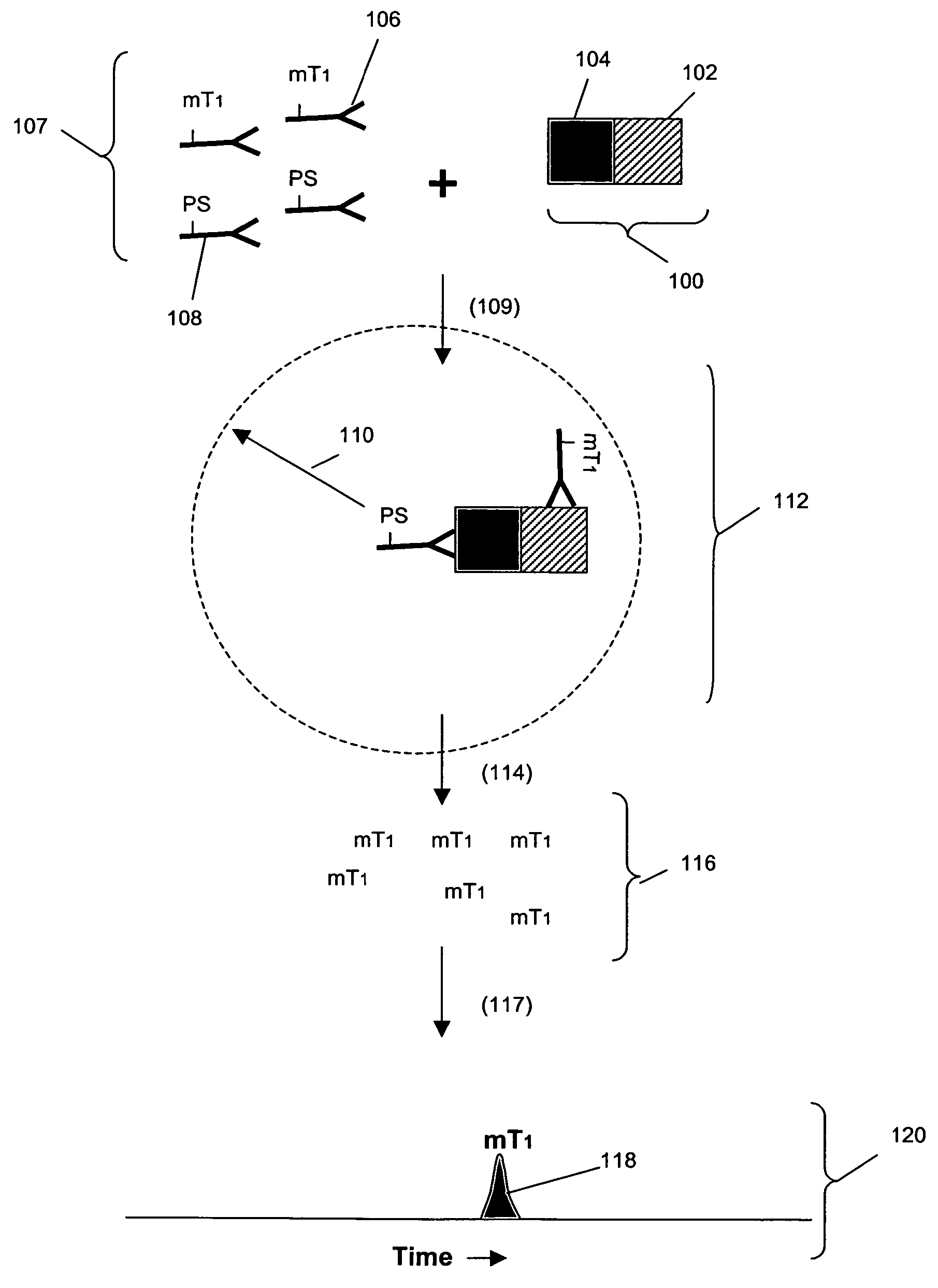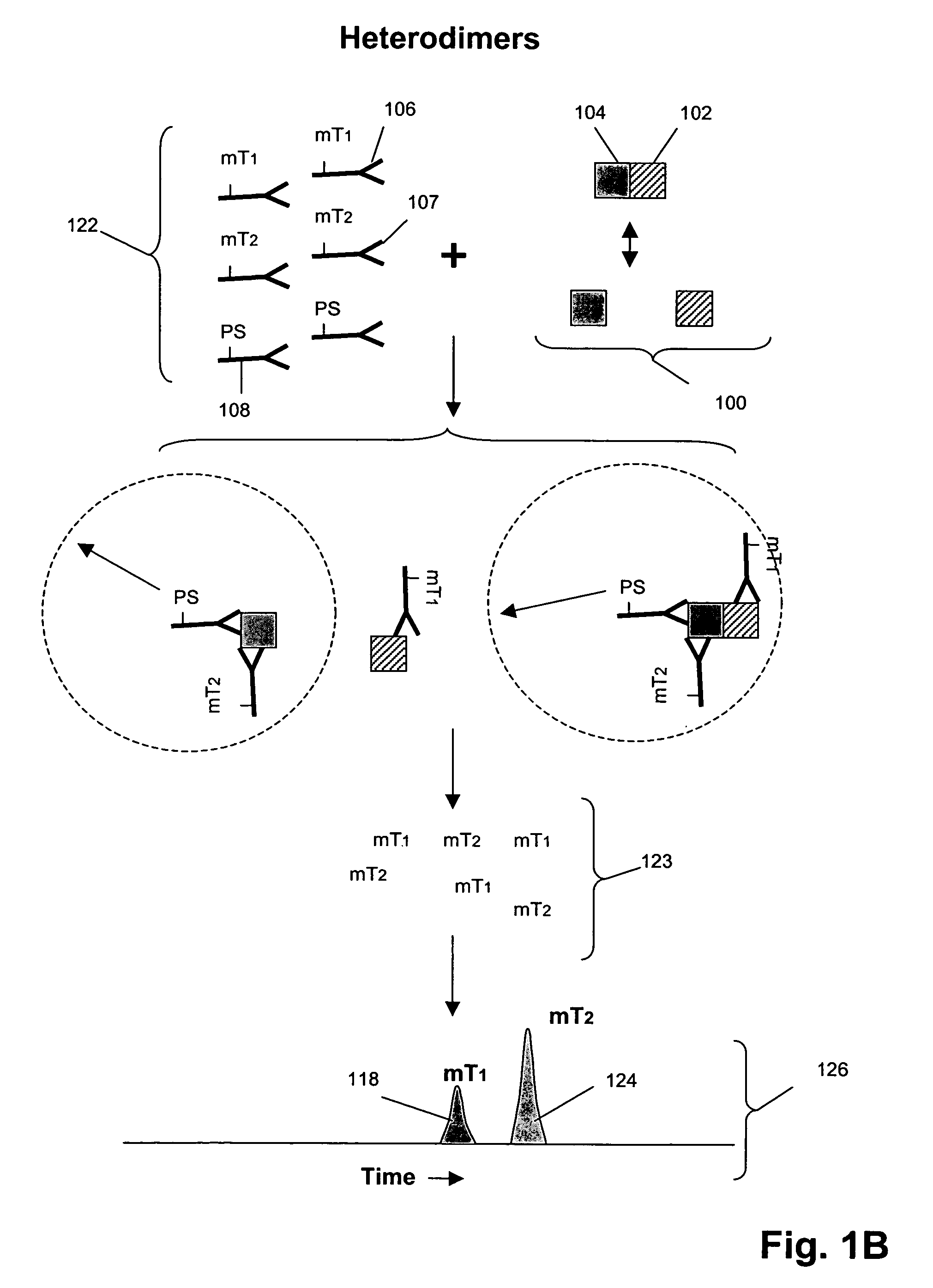Detecting and profiling molecular complexes
a molecular complex and complex technology, applied in the field of molecular complex detection and profiling, can solve the problems of difficult application of techniques, difficult study of phosphorylation states of signaling proteins, difficult study of signaling pathways, etc., and achieves convenient multiplexing capability, reduced background, and improved sensitivity
- Summary
- Abstract
- Description
- Claims
- Application Information
AI Technical Summary
Benefits of technology
Problems solved by technology
Method used
Image
Examples
example 1
PI3K / Her-3 Receptor Activation Complex
[0170]In this example, assays were designed as shown in FIGS. 7A and 7C to measure a receptor complex comprising Her2, Her3, and PI3K in breast cancer cell line, MCF-7. Binding compound (1106) having a first molecular tag (“mT1” in the figure and “eTag1” below) is specific for the extracellular domain of Her3 receptor (1102), binding compound (1110) having a second molecular tag (“mT2” in the figure and “eTag2” below) is specific for the p85 component (1111) of PI3K protein (1100), and cleaving probe (1108) having a photosensitizer attached (is specific for the intracellular domain of Her3 receptor (1102) where “H2” indicates a Her2 receptor (1104), “H3” indicates a Her3 receptor (1102), “p85” and “p110” are components of PI3 kinase (1100), which binds to a phosphorylation site of H3 (denoted by “P”) through its p85 moiety. The two assay designs are similar, except that in the design of FIG. 7A the cleaving probe is specific for the Her3 recepto...
example 2
Shc / Her-3 Receptor-Adaptor Interaction
[0198]In this example, an assays were designed as shown in FIGS. 8A and 8C. In FIG. 8A, Her2 receptor (1200) and Her3 receptor (1202) form a dimer in cell surface membrane (1204) and each receptor is represented as having phosphorylated sites (1209 and 1210). Shc proteins (1206 and 1208) bind to phosphylation sites (1210) and (1209), respectively. A first binding compound (1214) and cleaving probe (1216) are specific for different antigenic determinants of the extracellular domain of Her2 receptor (1200). A second binding compound (1212) is specific for Shc proteins (1206 and 1208). The assay designs of FIGS. 8A and 8C are similar, except that in the design of FIG. 8A the cleaving probe is specific for the Her2 receptor, and in the design of FIG. 8C, the cleaving probe is specific for the Her3 receptor. Thus, in the former case, total Her2 receptor is measured, whereas in the latter case total Her3 receptor is measured. The assays were carried o...
example 3
SHC / / Grb2 Protein-Protein Interaction
[0222]In this example, an assay was designed as shown in FIG. 1B to detect Grb2 / / SHC protein-protein complexes in cell lysates. A first binding compound having a first molecular tag was specific for Grb2 and a cleaving probe was provided that was specific for a separate antigenic determinant of Grb2 than that of the first binding compound. A second binding compound specific for SHC having a second molecular tag was also provided. The assays were carried out as follows. Sample preparation was carried out as above.
[0223]The total assay volume is 40 ul. The lysate volume is adjusted to 10 ul with lysis buffer.
The antibodies are diluted in lysis buffer up to 20 ul. Typically about 5000 to 500,000 cell-equivalent of lysates is used per reaction.
[0224]Procedure: Working concentrations of pre-mixed antibodies prior to adding into reaction:[0225]For Grb2 / / SHC complex with cleaving probe at Grb2:[0226]eTag1_anti-Grb2 at 10 nM (eTag1 was Pro14 in this assa...
PUM
| Property | Measurement | Unit |
|---|---|---|
| molecular weight | aaaaa | aaaaa |
| diameter | aaaaa | aaaaa |
| pressure | aaaaa | aaaaa |
Abstract
Description
Claims
Application Information
 Login to View More
Login to View More - R&D
- Intellectual Property
- Life Sciences
- Materials
- Tech Scout
- Unparalleled Data Quality
- Higher Quality Content
- 60% Fewer Hallucinations
Browse by: Latest US Patents, China's latest patents, Technical Efficacy Thesaurus, Application Domain, Technology Topic, Popular Technical Reports.
© 2025 PatSnap. All rights reserved.Legal|Privacy policy|Modern Slavery Act Transparency Statement|Sitemap|About US| Contact US: help@patsnap.com



